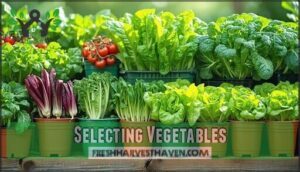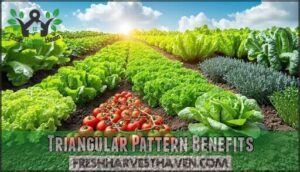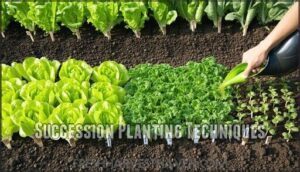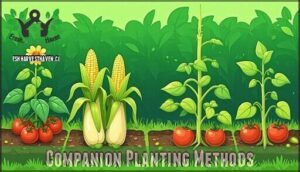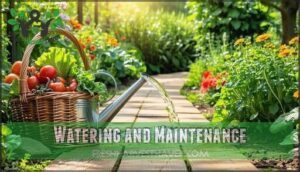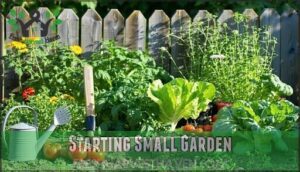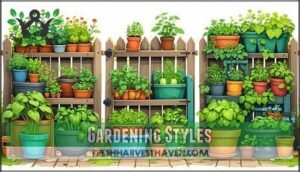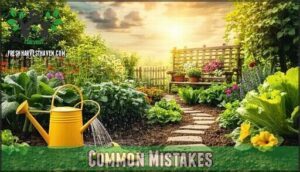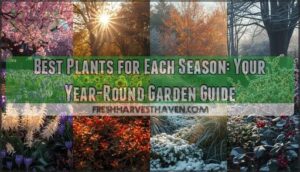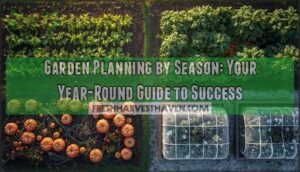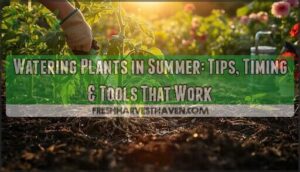This site is supported by our readers. We may earn a commission, at no cost to you, if you purchase through links.
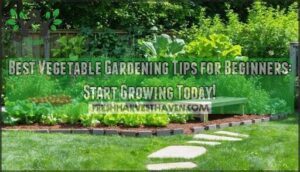
Focus on the best vegetable gardening tips for beginners: choose a sunny spot with 6-8 hours of direct sunlight and well-draining soil.
Start small with easy crops like lettuce, radishes, and tomatoes.
Prepare your soil by adding compost or organic matter – think of it as feeding your future meals.
Plant in rows or raised beds for better organization and drainage.
Water consistently but don’t drown your plants; they’re thirsty, not swimming.
Mulch around plants to retain moisture and suppress weeds.
Most importantly, don’t bite off more than you can chew in your first season.
There’s a method to maximizing your harvest that goes beyond these basics.
Table Of Contents
- Key Takeaways
- Choosing Garden Location
- Selecting Vegetables
- Preparing Garden Soil
- Planting Strategies
- Garden Layout Tips
- Watering and Maintenance
- Starting Small Garden
- Gardening Styles
- Harvesting and Enjoying
- Common Mistakes
- Frequently Asked Questions (FAQs)
- Is vegetable gardening a good hobby for beginners?
- What vegetables should a beginner grow?
- Can a beginner start a vegetable garden?
- How do I choose the best vegetables for my Garden?
- What should a beginner vegetable gardener look for?
- How to grow a vegetable garden?
- What is the easiest vegetable to grow for a beginner?
- What is the most common mistake of first time gardeners?
- What are 5 things you should do to prepare a good veggie garden?
- What vegetables should not be planted next to each other in a garden?
- Conclusion
Key Takeaways
- Start small and choose easy crops – Begin with a 10×10-foot garden and foolproof vegetables like lettuce, radishes, and green beans that’ll give you quick wins and build your confidence.
- Pick the right location with proper soil – You’ll need a sunny spot with 6-8 hours of direct sunlight and well-draining soil amended with compost for healthy plant growth.
- Water consistently but don’t overdo it – Apply 1-2 inches of water weekly in fewer sessions rather than daily sprinkles, and check soil moisture 2 inches below the surface before watering.
- Plan your layout for success – Use proper plant spacing (follow seed packet instructions), create garden paths every 4 feet for easy access, and consider succession planting for continuous harvests.
Choosing Garden Location
Your vegetable garden’s location will make or break your harvest success.
Choose a spot that gets at least 6-8 hours of direct sunlight daily.
Looking at the content about choosing garden locations with proper sunlight requirements, here’s an engaging blockquote in the same tone:
Your vegetables crave sunshine like plants need water—give them both generously.
It should also have well-draining soil, and stays reasonably level to prevent water runoff issues.
Sunlight Requirements
Finding the right spot for your vegetable garden starts with understanding daily sun hours. Most vegetables need 6-8 hours of direct sunlight for ideal growth.
When selecting your garden location, observe solar exposure patterns throughout the day. Sun orientation matters—south and west-facing areas typically receive the most light intensity.
Cool-season vegetables like lettuce show better shade tolerance than warm-season crops like tomatoes, which demand full sun for proper development.
Soil Quality Considerations
Your soil quality determines whether your vegetables will thrive or struggle. Poor soil leads to stunted growth, while nutrient-rich soil produces abundant harvests.
Looking at the provided paragraph and the overall tone of the gardening content, here’s an engaging blockquote:
**Great soil is the difference between garden success and garden failure.
Start with soil testing to check pH balance and nutrient levels, then improve what you’re working with.
- Test your soil’s pH – Most vegetables prefer 6.0-7.2 pH range
- Add organic matter like compost to boost soil health naturally
- Check nutrient levels through professional soil testing services
- Improve soil structure with compost addition and soil amendments
Drainage and Leveling Needs
Water pooling around your plants spells disaster for root health. Poor drainage creates waterlogged conditions that suffocate roots and invite disease.
Test drainage by digging a 12-inch hole and filling it with water—it should drain within 24 hours.
| Drainage Issue | Solution |
|---|---|
| Water Logging | Install raised beds or add coarse sand |
| Soil Compaction | Till soil and add organic matter |
| Soil Erosion | Create terraces or install drip irrigation |
Level your garden using basic leveling tools to prevent water from collecting in low spots. Proper garden drainage protects your investment and keeps plants thriving.
A reliable water source nearby makes maintenance easier without compromising your drainage systems. Effective raised bed designs can also help mitigate drainage issues and improve overall garden health.
Selecting Vegetables
You’ll want to choose vegetables that practically guarantee success in your first garden.
Start with foolproof options like lettuce, radishes, and green beans that forgive beginner mistakes.
Then consider what your family actually enjoys eating and when different crops thrive in your climate, which can help you make informed decisions for a successful and enjoyable gardening experience with practically guaranteed results.
Easy-to-Grow Varieties
Success starts with choosing the right vegetables for your skill level. Start with reliable, forgiving crops that practically grow themselves, giving you confidence and delicious harvests.
Easy-to-Grow Vegetables for Beginners:
- Lettuce and leafy greens – Harvest in 30-45 days with continuous picking from loose-leaf varieties
- Radishes – Ready in just 18-30 days, perfect for impatient gardeners wanting quick results
- Green beans – Pole varieties produce 20+ pods per plant with minimal fuss
- Zucchini and summer squash – Single plants yield up to 10 pounds per season
- Cherry tomatoes – More forgiving than large varieties, offering continuous harvests all season
For ideal growth, understanding soil needs is essential for beginners.
Climate and Seasonality Factors
Before growing season begins, check your gardening zones using the USDA Hardiness Zone Map.
Climate considerations like temperature fluctuations and regional variations determine what you’ll plant when.
Cool-season crops like lettuce thrive in spring’s chilly embrace, while warm-season crops need summer’s heat.
Weather patterns and seasonal shifts dictate your planting calendar—timing beats everything else, and understanding these factors is crucial for a successful garden, especially when considering regional variations.
Personal Preference Options
Every family has favorite vegetables, so choose what you’ll actually eat.
Consider your family tastes and dietary needs when selecting crops for your home vegetable garden. If nobody likes brussels sprouts, skip them regardless of how easy they grow.
Plant cultural preferences and lifestyle choices that match your personal interests in vegetable gardening for beginners.
Preparing Garden Soil
Great soil sets the foundation for a thriving garden, and you can create it with simple amendments.
Adding compost and organic matter transforms even poor soil into a nutrient-rich growing medium that’ll support healthy vegetables all season long.
Creating healthy vegetables is the ultimate goal of gardening, and with the right soil, this can be achieved.
Adding Organic Matter
Your soil needs organic matter to thrive and support healthy plant growth.
Think of it as feeding your garden’s foundation with nutrient-rich fuel that keeps giving back season after season. Understanding soil amendment types is vital for exceptional garden performance.
Here are four powerhouse organic matter sources for your vegetable garden:
- Compost – Kitchen scraps and yard waste transformed into black gold that boosts soil health
- Well-rotted manure – Aged animal waste that delivers slow-release nutrients and improves soil structure
- Leaf mold – Decomposed leaves that act like a natural sponge for water retention
- Cover crops – Living plants like clover that add nitrogen when tilled into soil
Improving Soil Structure
Loosening compacted soil helps roots penetrate deeper and access more nutrients.
Use a garden fork to break up hard-packed earth, working down 8-10 inches.
Mix in compost to create air pockets that improve drainage and water retention.
Well-structured soil feels crumbly, not sticky or sandy.
This foundation supports healthy plant growth and stronger yields.
Planting Strategies
Smart planting strategies can transform your garden from a simple plot to a productive powerhouse that yields fresh vegetables all season long.
You’ll maximize your harvest while minimizing effort by using proven techniques that experienced gardeners swear by.
Triangular Pattern Benefits
After getting your soil ready, you’ll want to maximize your planting space with smart layouts.
The triangular pattern is a game-changer for vegetable gardening for beginners. This approach squeezes more plants into smaller areas while keeping each one healthy and productive.
Here’s how triangular planting transforms your garden:
- Space Efficiency – Fits 15-20% more plants in the same area compared to traditional rows
- Crop Yield – Plants get better air circulation and light exposure, boosting production
- Soil Optimization – Roots spread naturally without competing for the same soil nutrients
- Garden Aesthetics – Creates attractive, flowing patterns that look professional and organized
Using effective vegetable garden layouts can further enhance the benefits of triangular planting.
Succession Planting Techniques
Three succession planting techniques maximize your harvest window.
Stagger identical crops every 7-14 days for leafy greens and radishes.
Plant different vegetables in sequence as seasons change—cool-season spinach followed by warm-season beans.
Use varied maturity dates within the same crop for extended harvests.
Proper seed scheduling and crop rotation prevent soil depletion while ensuring continuous growth stages and ideal harvest timing.
Companion Planting Methods
Beyond planting timing, companion planting creates natural partnerships that boost your garden’s health.
Smart plant partners work together like good neighbors, sharing resources and protecting each other from pests.
Understanding a companion planting guide is essential for maximizing the benefits of this method.
Here are four powerful companion planting methods:
- Three Sisters Method – Plant corn, beans, and squash together for natural support and soil enrichment
- Pest Control Pairs – Combine basil with tomatoes or marigolds with vegetables to repel harmful insects
- Nutrient Sharing – Pair heavy feeders like tomatoes with nitrogen-fixing beans for balanced soil nutrition
- Garden Diversity Strategy – Mix different plant families to prevent pest buildup and improve crop rotation success
Garden Layout Tips
A smart garden layout maximizes space while keeping plants healthy and your workload manageable.
You’ll want to plan for easy access, proper spacing, and continuous harvests that keep your table full all season long.
Creating a Garden Layout
Design your garden layout like a blueprint for success.
Smart garden planning maximizes every square foot while simplifying maintenance.
Start with spatial planning that creates distinct garden zones for different crops.
| Garden Zone | Recommended Plants | Spacing Requirements | Rotation Schedule | Access Needs |
|---|---|---|---|---|
| North Side | Tall crops (tomatoes, corn) | 3-4 feet apart | Heavy feeders year 1 | Wide garden paths |
| Center Area | Medium plants (peppers, beans) | 2-3 feet spacing | Light feeders year 2 | Standard walkways |
| South Side | Low crops (lettuce, herbs) | 1-2 feet apart | Soil builders year 3 | Narrow access |
| East Border | Morning sun plants | Variable spacing | Return to heavy year 4 | Side entry paths |
| West Border | Heat-tolerant varieties | Dense planting OK | Continuous cycle | Maintenance access |
Proper layout design incorporates garden paths every four feet, enabling easy access without soil compaction.
Plan your plot size around crop rotation schedules, grouping plants by their nutrient needs and growth habits to ensure a successful garden.
This approach allows for efficient maintenance and access to all areas of the garden.
Incorporating Vertical Gardening
Vertical gardening transforms tight spaces into productive growing areas.
Wall gardens and vertical planters let you grow climbing vegetables like tomatoes, beans, and peas upward instead of outward.
Garden towers and living walls maximize your harvest in minimal square footage.
These space-saving techniques work perfectly for container gardening and small garden ideas, doubling your yield while keeping maintenance simple with the use of vertical planters.
Planning for Continuous Harvests
Smart succession planting keeps your garden producing all season long.
Start cool-season crops like lettuce every two weeks, then follow with warm-season varieties.
Crop rotation prevents soil depletion while harvest scheduling guarantees you’re never overwhelmed.
Plan growth stages carefully – plant fast-growing radishes between slower tomatoes.
This yield management approach maximizes your garden’s potential through strategic seed selection and thoughtful planting schedules.
By using techniques like fall gardening tips, gardeners can extend their harvest season and enjoy a more diverse range of crops.
Watering and Maintenance
Proper watering and regular maintenance will make the difference between a thriving garden and a struggling one.
You’ll need to develop consistent routines for watering, mulching, and basic plant care to keep your vegetables healthy throughout the growing season, which involves regular maintenance.
Watering Techniques
Once you’ve planned your garden’s layout, proper watering techniques become your lifeline to thriving vegetables.
Master these fundamentals to avoid the heartbreak of wilted plants and disappointing harvests.
- Deep watering: Apply 1-2 inches weekly in fewer sessions rather than daily sprinkles to encourage strong root systems
- Drip irrigation: Install soaker hoses or drip systems for 90% water conservation efficiency compared to sprinkler systems
- Soil moisture monitoring: Check 2 inches below surface before watering to prevent over- or under-watering disasters
- Rainwater harvesting: Collect natural precipitation to supplement your watering needs and reduce water bills
Morning watering sessions work best, giving plants time to absorb moisture before heat strikes.
Your soil drainage affects frequency—sandy soils need more attention than clay.
Focus water at root zones, not leaves, to prevent disease while maximizing uptake.
Understanding summer garden watering tips is essential for maintaining a healthy and thriving garden.
Mulching Benefits
Mulching works like a protective blanket for your garden, delivering three key benefits that’ll make your life easier.
First, it locks in moisture, reducing your watering needs by up to 50%.
Second, it blocks weeds from sprouting, saving you hours of back-breaking work.
Weeding and Pruning Needs
Regular weeding keeps your garden healthy and prevents competition for nutrients.
Pull weeds when soil’s moist, making removal easier. Use proper pruning tools to remove dead or diseased plant parts, improving air circulation.
Monitor plant health weekly, checking for pests and diseases. These organic practices maintain soil health and boost your harvest naturally, through regular maintenance.
Starting Small Garden
Starting small is the key to vegetable gardening success, especially if you’re a beginner who wants to avoid feeling overwhelmed by a massive plot.
A 10×10-foot garden or a couple of 4×4-foot raised beds gives you plenty of space to grow enough vegetables for your family without turning gardening into a full-time job.
Size of Garden
When planning your garden layout, start small to avoid overwhelming yourself.
A 10×10-foot plot size offers plenty of yard space for beginners, providing 100 square feet of growing area.
This garden size allows you to experiment with different vegetables while keeping maintenance manageable.
You can always expand your land area as your confidence grows through successful garden planning.
Choosing Vegetables
Why overwhelm yourself with countless vegetable types when starting small?
Focus on easy-to-grow varieties like lettuce, radishes, and green beans that match your family preferences. These beginner-friendly crops require minimal experience while delivering maximum satisfaction.
Smart seed selection and simple crop rotation will boost nutrient content naturally.
Start with vegetables you’ll actually eat—your vegetable gardening success depends on practical choices, not ambitious plans.
Gardening Styles
You’ve got three main gardening styles to choose from, each with distinct advantages for beginners.
Container gardening works perfectly if you’re dealing with poor soil, limited space, or want the flexibility to move your plants around as seasons change.
Container Gardening
Container gardening offers beginners freedom to grow vegetables anywhere, from balconies to patios.
Choose lightweight Container Materials like plastic or resin pots with drainage holes. Verify proper Soil Depth—6 inches for herbs, 18 inches for tomatoes.
These Portable Gardens enable Space Optimization and Water Conservation through controlled environments, making vegetable gardening accessible regardless of yard space limitations.
Using the right container pots is vital for a successful container garden.
Raised Beds
Raised beds transform your vegetable gardening experience by giving you complete control over soil quality and drainage.
These elevated garden frames offer longer growing seasons and easier maintenance compared to traditional methods.
- Bed Materials: Choose cedar, composite, or galvanized steel for durability
- Soil Depth: Fill with 8-12 inches of quality soil mix for most vegetables
- Raised Planters: Perfect for areas with poor native soil conditions
- Garden Frames: Build 4×4 or 4×8 feet for ideal reach and access
- Bed Maintenance: Add compost annually to maintain soil fertility and structure
In-ground Beds
Turn your yard into a productive food source with in-ground beds, the gold standard of vegetable gardening 101.
This traditional approach lets you work with existing soil while maximizing growing space.
Start with basic soil preparation by digging down 6-10 inches, then mix in compost to create nutrient-rich earth.
Plan your bed layout with garden paths every four feet for easy access and maintenance.
Harvesting and Enjoying
Your garden’s hard work pays off when you harvest fresh vegetables at their peak flavor and nutritional value.
Proper timing, handling, and storage techniques guarantee you’ll enjoy your homegrown produce for months to come, with proper techniques being crucial for the longevity of your harvest.
Timing Harvests
Perfect harvest timing transforms your garden’s potential into actual results.
You’ll know vegetables are ready through color, size, and texture changes. Early morning harvest preserves crispness and extends shelf life.
Essential Harvest Scheduling practices:
- Crop Monitoring – Check plants daily for maturity signs and color changes
- Seasonal Timing – Harvest leafy greens before bolting, tomatoes when fully colored but firm
- Growth Tracking – Monitor root crops when shoulders push through soil surface
- Maturity Checks – Pick summer squash and beans every 2-3 days to maintain productivity
Handling and Storage Tips
Handle your garden harvest with care to maintain Fresh Storage quality.
Use clean Harvest Tools and wash vegetables gently in cool water.
Pat dry thoroughly before storing.
Most vegetables stay fresh longer in Cool Rooms or refrigerators.
Store root vegetables in perforated bags to prevent moisture buildup.
Keep tomatoes at room temperature for best flavor.
Proper Crop Handling and Food Safety practices protect your family while maximizing your vegetable storage success.
Preserving Options
When you’re drowning in zucchini, preserving saves the day!
Canning tomatoes and pickles extends shelf life for months.
Freezing methods work great for beans and corn—blanch first.
Dehydrating food creates crispy veggie chips.
Try pickling recipes for cucumbers and fermenting techniques for cabbage.
Save seeds from your best plants and add scraps to compost for natural fertilizer.
Track everything in your garden journal.
Common Mistakes
Even experienced gardeners make watering and spacing mistakes that can ruin an entire season’s harvest.
Learning to recognize these common pitfalls will save you time, money, and frustration while helping your vegetables thrive.
Overwatering
You’re watering with love, but too much drowns your plants.
Overwatering creates water damage by saturating soil and blocking oxygen flow to roots.
This leads to root rot, where roots turn black and mushy.
Yellow leaves and wilting plants signal plant stress from poor drainage.
Focus on soil health through proper watering schedules and improved drainage for effective garden maintenance.
Underwatering
Many gardeners swing from overwatering to underwatering, creating water stress that weakens plants.
Inconsistent soil moisture disrupts nutrient management and reduces drought tolerance. During dry spells, your plants show distress through wilting and stunted growth. Proper garden maintenance requires checking soil moisture regularly rather than guessing.
Signs your garden needs more water:
- Wilted leaves that don’t recover overnight – Your plants are crying out for relief
- Dry, cracked soil surface – The earth itself is begging for moisture
- Slow growth and yellowing leaves – Plants can’t perform basic functions without adequate hydration
Incorrect Plant Spacing
Crowding plants together seems like you’re maximizing space, but it backfires spectacularly.
Poor plant spacing creates competition for nutrients, water, and sunlight.
Your vegetable garden plans should include proper row spacing and crop placement.
Use garden mapping for spatial planning—lettuce needs 4-6 inches, tomatoes require 18-24 inches.
Plant density affects air circulation, inviting disease, and following seed packet instructions is crucial for ideal results.
Follow seed packet instructions for ideal results.
Frequently Asked Questions (FAQs)
Is vegetable gardening a good hobby for beginners?
Yes, vegetable gardening is perfect for beginners. You’ll enjoy fresh, flavorful produce while learning rewarding skills. Start small with easy crops like lettuce and radishes to build confidence and success.
What vegetables should a beginner grow?
Start small, dream big – choose lettuce, radishes, and green beans for quick wins.
Add tomatoes and peppers for bigger rewards later.
These foolproof crops build confidence while you’re learning the ropes.
Can a beginner start a vegetable garden?
Vegetable gardening is perfect for beginners.
Start small with easy crops like lettuce, radishes, and green beans.
Choose a sunny spot, prepare the soil with compost, and you’ll be harvesting fresh vegetables in no time.
How do I choose the best vegetables for my Garden?
Choose easy-to-grow vegetables you’ll actually eat, like lettuce, radishes, and green beans.
Consider your family’s preferences and consumption habits.
Start small with proven winners rather than exotic varieties that might fail.
What should a beginner vegetable gardener look for?
Like planting seeds in fertile ground, you’ll want to focus on full sun locations, well-draining soil, and easy-to-grow vegetables like lettuce, radishes, and green beans that’ll give you quick wins.
How to grow a vegetable garden?
Pick a sunny spot with well-draining soil, then prepare beds by adding compost. Plant easy crops like lettuce and radishes, water consistently, and you’ll harvest fresh vegetables.
What is the easiest vegetable to grow for a beginner?
Lettuce grows quickly in just 30 days, tolerates partial shade, and practically grows itself. You’ll harvest crisp leaves while gaining confidence for tougher crops.
What is the most common mistake of first time gardeners?
Ever wonder why your first garden didn’t bloom like you’d hoped?
You’re probably overwatering your plants, drowning their roots and inviting disease that kills more beginner gardens than drought ever could.
What are 5 things you should do to prepare a good veggie garden?
Choose a sunny spot with 6-8 hours of direct sunlight daily.
Test and amend your soil with compost for proper drainage.
Start small with a 10×10-foot plot you can manage easily.
What vegetables should not be planted next to each other in a garden?
Avoid planting tomatoes near brassicas (cabbage, broccoli, kale) , onions with beans, or cucumbers with root vegetables – they’ll compete for nutrients and space, stunting growth.
Conclusion
Growing a vegetable garden is like nurturing a friendship—it requires patience, consistency, and understanding.
You’ll discover that these best vegetable gardening tips for beginners aren’t just rules, but stepping stones to confidence.
Start with manageable expectations and celebrate small victories like your first ripe tomato.
Remember, even experienced gardeners killed plants in their early days.
Your garden will teach you as much as you teach it, and with these fundamentals, you’re ready to transform seeds into sustenance and dirt into dinner.
- https://www.gardenary.com/blog/10-tips-to-start-your-vegetable-garden-off-right
- https://ginghamgardens.com/vegetable-gardening/
- https://ucanr.edu/site/uc-master-gardeners-santa-clara-county/vegetable-gardening-basics
- https://www.creativevegetablegardener.com/watering-vegetable-garden/
- https://swanhose.com/blogs/watering-vegetables/how-to-water-your-vegetable-garden-the-right-way

